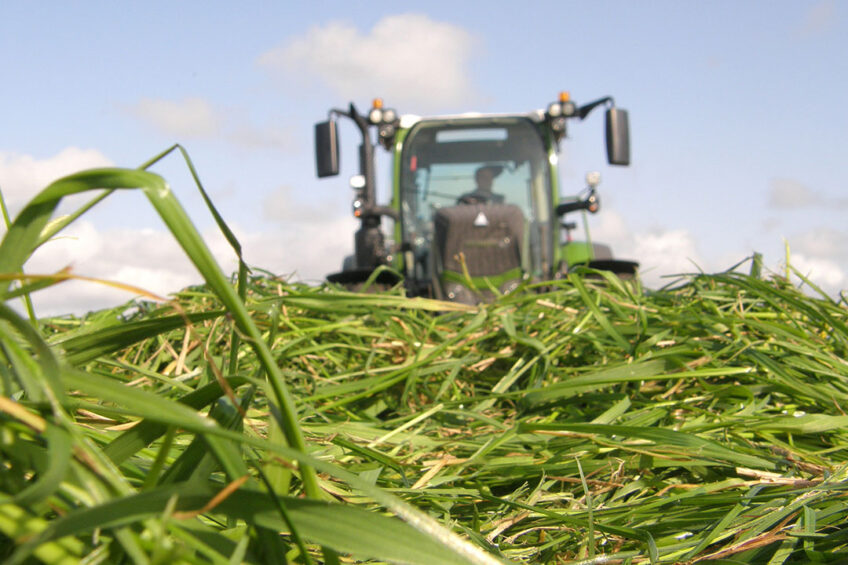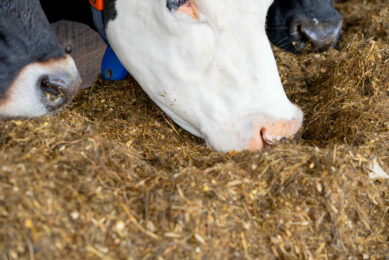Mixing grass seeds for maximum forage intake

Dairy farmers know very well that fresh grass is the cheapest form of feed needed for their cows to produce quality milk at a profit. However, cows can be quite fussy eaters, and farmers need to ensure they make the right choices when picking grass seed varieties and mixes.
In order to maintain good quality grass in the fields, farmers generally need to reseed 10–15% of their land each year. It can cost around € 500 to € 900 to reseed one hectare of grassland so it is vital that the right choices are made to suit the growing conditions and soil type.
Establishing a new ley has the benefits of improving the grass yield, quality and disease resistance and also means it can last 5 to 10 years over an existing sward.

Naturally, over time these benefits gradually decline depending on the soil health, nutrition, weed control and general grassland management practised on the farm each year.
Seeding can be carried out in spring or autumn. While both these periods have their own advantages and disadvantages, the main decision on when to seed should be taken after analysing soil samples from the desired field.
Farm report: Making the most of a grass-oriented farm
Wout Huijzer and Nely Schutte maintain a tight pasturing schedule. They aim to make the most of their 100% grass-oriented farm. Read more…
The right grass variety
Cows can be picky eaters and often prefer some fields over others. This taste preference can be boiled down to the grass variety used to seed the field.
Cows often like to show their dissatisfaction with grass if they don’t like it by becoming unsettled and roaring most of the day. If they don’t eat the grass it is left and the field is poorly grazed, which is a waste of money.
This poor graze-out increases the proportion of stem in the sward at the next grazing, which is less digestible than leaf and can cause a drop in milk production. Choosing the correct grass variety is crucial to ensure reseeding costs are well spent and that the grazing efficiency is maximised. Most reseeds are probably a mixture of diploid and tetraploid perennial ryegrasses. However, other types of ryegrass and species such as clover, cocksfoot and timothy may have a role to play in certain situations. Each type of grass has different growth and quality characteristics, so when reseeding it is important to select the most appropriate species for the situation.

Testing grass varieties
During a trial at Teagasc Moorepark in the Republic of Ireland a number of grass varieties were tested to investigate their graze-out potential.
In total, 30 perennial ryegrass varieties from the DAFM Recommended List were sown in 36m2 plots and rotationally grazed from February to November on 11 occasions. On average the trial grew 15t of dry matter (DM) per hectare over the year. Before grazing, the yield and height were measured and samples collected for digestibility. The after-grazing heights were measured with a rising plate meter as the measure of graze-out, so swards with lower post-grazing heights had greater levels of utilisation. During the tests, varieties with larger pre-grazing heights were found to have poorer graze-out and from this a new characteristic of grazing quality called the Residual Grazed Height (RGH) was calculated.
The results showed that tetraploid varieties were among those grazed-out the most, with diploids generally yielding well but not grazing-out tightly. The majority of tetraploids had better graze-out performance than diploids even when DM production was similar between both ploidies.
How to deal with low grass yields for dairy cows
The different climates have had a detrimental effect on grass growing rates forcing dairy farmers to think fast to make compensatory arrangements. Read more…
Mixing grass seed varieties
Using a mix of grass seed varieties has a number of benefits for both the farmer and the sward.
These include risk management because using a mix minimises the risk of a crop of seed failing. A mix also ensures sward quality throughout the grazing season, and it can achieve a balance of desirable traits. When varieties with close heading dates are sown together, this increases competition between varieties, resulting in an increase in DM yield compared with the average yield of the component varieties sown separately. In contrast, mixtures with a wide heading date range have a lower yield than the corresponding weighted average of their components. In the first year after sowing, most mixtures are likely to change in their composition from what was sown. Early studies suggest that, in mixtures managed for grazing, later-heading varieties become more dominant, while in silage mixtures, the contribution of earlier-heading varieties tends to increase. In addition, mixtures with a greater heading date range will change more than those with a smaller heading date range.
For farmers it’s better to use a mixture because of several reasons,”
Tom Niehof, the product manager for forage at Barenbrug, outlines the key benefits achieved using grass seed mixes. “For farmers it’s better to use a mixture because of several reasons,” he said. “The main reason is spreading risks in terms of growing conditions, harvest flexibility and persistence, for example, with drought resistance and winter hardiness being important.
“The result in your pasture should be a balance between yield potential, animal productivity and climatic or soil adaptation. Every single grass species and/or variety has its own characteristics.
“That’s why we make specific mixtures into a concept to combine the benefits and eliminate possible risks. Normally we combine 3 to 5 varieties into a mixture. Depending on purpose, it can be also up to 5 species.
“When farmers use grasses as forage for ruminants in animal production the main reasons are as a source of protein, energy and digestible fibres. They also need it to stimulate animal health and as a source of palatable feed.
“With this in mind, you can imagine that using a mix will fit better in someone’s strategy than using a single variety,” adds Niehof.
Grazing: Considering the opportunities for dairy cows
Grazing plays an important role in milk production in most regions. The future is bright for this production system if we consider all the opportunities it presents. Read more…
Clover inclusion
Using white clover in mixtures with perennial ryegrass in a farm system can boost sward production and lead to higher milk solids production. Previous research has shown that white clover use can reduce the need for chemical nitrogen inputs due to a process called biological nitrogen fixation, which occurs in the root nodules of the white clover plant.
However, despite these benefits, white clover is still not being fully exploited on many dairy farms.
In other research over a 3-year period, diploid and tetraploid swards produced the same amount of grass, but when white clover was included there was an extra 1.5t of herbage DM produced each year (17t compared to 15.5t DM/ha/year).
The white clover content declined from 36% to 18% over the 3 years but this still maintained higher sward DM production than swards without any white clover. Overall, for every 1% increase in clover content there was an increase in herbage production of around 40kg DM/ha.
In addition, swards containing clover were grazed out more efficiently, as shown by a decrease in post-grazing height from 4.32cm in pure grass swards to 3.91cm in grass/clover swards.
The grass/clover swards also had improved nutritive value in terms of digestibility and protein content.
Managing white clover swards
White clover is clearly a very different plant from perennial ryegrass, with a different growing habit. It has a lower winter growth rate but has a much higher growth rate in summer and autumn.
This means grass/clover swards often have a lower opening farm cover in spring but shorter rotations in summer, due to the extra forage being produced.
As white clover has high protein and is highly digestible, there is a risk of bloat, but only when sward clover content is high (typically over 40%).
Join 13,000+ subscribers
Subscribe to our newsletter to stay updated about all the need-to-know content in the dairy sector, two times a week.










